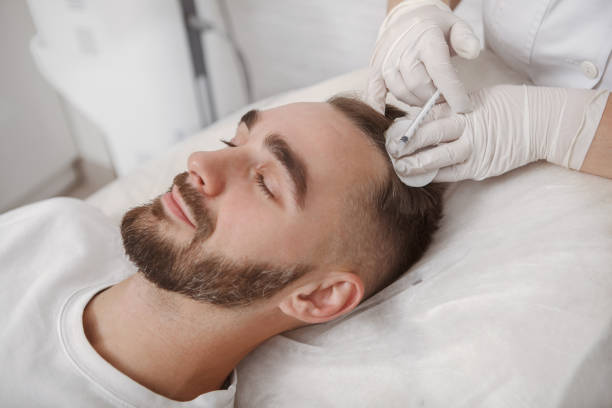PRP for hair loss has become a popular treatment option for those looking to combat the effects of hair loss. But what exactly is PRP, and how does it work to help promote hair growth? In this blog post, we will decode PRP and explore how it battles hair loss effectively.
Understanding PRP and Its Origins
Platelet-Rich Plasma (PRP) therapy, a groundbreaking approach in the treatment of hair loss, leverages the healing powers inherent within our own blood. This innovative procedure extracts a patient’s blood, which is then processed to enrich the plasma with platelets, the blood components laden with growth factors and proteins essential for tissue regeneration and healing. This concentrated plasma is subsequently reintroduced into the scalp, targeting areas afflicted by hair thinning or balding.
Initially finding its application within the medical realm for healing injuries and aiding recovery in various surgical procedures, PRP’s potential to also invigorate hair follicles and encourage new hair growth was an evolutionary leap. This transition from healing physical injuries to addressing hair loss showcases the versatility and healing potential of PRP therapy, marking a significant milestone in its journey from a medical aid to a cosmetic solution. As its effectiveness became increasingly apparent, PRP therapy quickly emerged as a beacon of hope for individuals grappling with the challenges of hair loss, seeking a minimally invasive solution.
The Science Behind PRP for Hair Loss
The efficacy of PRP in combating hair loss lies in its rich concentration of growth factors and proteins, which are instrumental in the body’s natural healing and regenerative processes. When PRP is injected into the scalp, these potent components stimulate the dormant hair follicles, encouraging them to shift from a resting phase into an active growth phase. This not only enhances blood circulation within the scalp but also facilitates the development of new, stronger hair strands. Furthermore, the PRP for hair loss therapy aids in diminishing scalp inflammation, a common contributing factor to hair loss, thereby fostering a healthier environment conducive to hair regeneration. The targeted delivery of PRP’s growth factors directly to the hair follicles provides a strategic approach to revitalizing weakened hair and promoting a fuller, more vibrant head of hair without the need for invasive procedures or long-term medication use.
What to Expect During a PRP Treatment Session
A PRP treatment session for hair loss is a straightforward and efficient procedure that usually lasts about an hour. Initially, a small amount of blood is drawn from the patient, similar to a routine blood test. This blood is then placed into a centrifuge where it is spun to separate the plasma from other blood components. The platelet-rich plasma obtained is then prepared for injection.
The key part of the session involves injecting the PRP directly into the scalp at the areas of hair thinning or loss. This is done using a fine needle to minimize discomfort. To further ease any potential discomfort, a local anesthetic or numbing cream may be applied to the scalp before the injections. Despite this, some patients might feel a mild pressure or a sensation of tightness during the procedure.
Post-procedure, there’s no significant downtime required, allowing patients to return to their daily activities almost immediately. It’s common for the treated area to have some redness, tenderness, and possibly slight swelling, but these minor side effects usually resolve quickly. In the following weeks, patients are advised to avoid harsh chemical hair treatments and excessive sun exposure to the scalp to ensure optimal healing and effectiveness of the treatment.
Evaluating the Effectiveness of PRP for Hair Loss
The effectiveness of PRP in managing hair loss has been substantiated through numerous scientific studies, showcasing its potential to significantly enhance hair density and thickness while stimulating new hair growth across diverse hair loss conditions. This innovative treatment has been found to be particularly beneficial for those not responding well to conventional therapies, marking it as a standout option in the realm of hair restoration. The inherent safety profile of PRP, given its autologous nature, further underscores its appeal, offering a reduction in the likelihood of adverse reactions commonly associated with other hair loss interventions. These studies affirm PRP’s role not just as an alternative, but as a potentially pivotal treatment in the multifaceted approach to tackling hair loss, underscoring its effectiveness and establishing its position within the broader spectrum of hair loss solutions.
Comparing PRP to Other Hair Loss Treatments
PRP stands as a distinctive choice in the landscape of hair loss treatments, offering a unique blend of benefits not found in traditional options. Compared to topical treatments, which can often lead to undesirable side effects, PRP therapy harnesses a patient’s own biological materials, significantly reducing the risk of adverse reactions. On the other hand, hair transplant surgery, while effective, is more invasive and requires a considerable recovery period. PRP therapy, conversely, is minimally invasive, involving only a series of injections, and allows patients to resume their normal activities shortly after the procedure. When used alongside other treatments, PRP not only complements their effects but may also enhance overall hair growth outcomes, making it a versatile addition to hair loss management strategies. This positions PRP as a compelling, non-surgical alternative for individuals exploring options beyond conventional treatments.
Conclusion
PRP therapy stands out as a cutting-edge, non-surgical remedy in the battle against hair loss, leveraging the body’s natural regenerative capabilities. This approach not only offers hope to those who have found traditional treatments ineffective but also presents a method with a favorable safety profile due to its use of the patient’s own biological material. The process, from preparation to injection, is straightforward and involves minimal downtime, making it an attractive option for individuals leading busy lives. Importantly, the science supporting PRP highlights its role in enhancing hair density, thickness, and stimulating new growth, affirming its efficacy. For those navigating the complexities of hair loss solutions, PRP therapy emerges as a promising alternative, capable of delivering significant improvements in hair health and appearance. As the landscape of hair restoration continues to evolve, PRP therapy remains a key player, offering a blend of simplicity, safety, and effectiveness.







